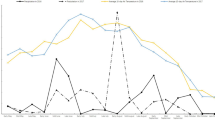Abstract
Field experiments in two successive seasons (1971–1972) were carried out to examine the effect of spraying table beet plants with chlormequat (CCC) on their growth and yield. Concentrations used were 500 and 1000 ppm. Spraying in the first season was carried out 60, 75 or 90 days after sowing. According to the result of the first season, which showed no significant differences according to varying spraying date, only one spraying time was chosen for the second season (75 days).
In both seasons, CCC exhibited modifications in growth and increased root yield significantly. Number of leaves and their dry weight per plant were increased. The increases in leaves dry weight per plant was found not to be a result of the increase of leaves number per plant only, but the leaves dry weight percentage was also increased
Root length showed insignificant increases due to CCC treatment. In the same time, significant increments in its diameter as well as in dry weight per plant were recorded in both seasons, which might be the cause of increasing yield. Ratio of leaves/roots (dry weight) was shifted in the treated plant towards the root side.
Zusammenfassung
In den Jahren 1971 und 1972 wurden zwei Feldversuche angelegt, um den Effekt der CCC Spritzbehandlung auf das Wachstum und den Ertrag von Roten-Rüben zu prüfen. Es wurden Konzentrationen von 500 und 1000 ppm angewandt. Im ersten Jahr erfolgte die Spritzung zu drei Terminen: 60, 75 oder 90 Tage nach der Aussaat.
Auf Grund der Ergebnisse des ersten Jahres, in dem die Spritztermine keinen Einfluß auf die Wirkungen der CCC Behandlungen hatten, entschied man sich im zweiten Jahr für nur einen Spritztermin und zwar 75 Tage nach Aussaat.
In beiden Jahren beeinflußte die CCC Behandlung das Wachstum und steigerte signifikant den Ertrag. Sowohl die Zahl der Blätter als auch deren Trockengewicht pro Pflanze erhöhten sich. Die Zunahme des Trockengewichts hing nicht nur mit der größeren Anzahl der Blätter pro Pflanze zusammen, sondern auch mit dem prozentualen Anstieg des Trockengewichts nach CCC Behandlung.
Die Wurzellänge zeigte keine signifikante Zunahme in Abhängigkeit von der CCC Behandlung, während sich der Wurzeldurchmesser ebenso wie das Trockengewicht pro Pflanze signifikant in beiden Jahren erhöhte, worin der Grund für die Ertragssteigerung zu suchen sein wird. Das Verhältnis der Trockengewichte Blätter/Wurzeln verschiebt sich in den behandelten Pflanzen zu Gunsten der Wurzeln.
Similar content being viewed by others
References
El-Fouly, M. M. (1973). Aus dem Pflanzenbau Ägyptens: Versuche mit Wuchsregulatoren.Landw. im Ausland 7:13–14.
El-Fouly, M. M., Massoud, Y. A. & El-Hindi, M. (1971) Stimulating sweet potato yields.World Crops 23:133.
El-Fouly, M. M., Salib, J. G. & El-Baz, F. K. (1968) Effect of CCC on cotton plants.Z.f. Pflanzenernähr. Bkd. 121:66–76.
El-Mansy, A. A., El-Beheidi, M. & El-Fouly, M. M. (1972) Growth and yield responses of carrots to chlormequat chloride (CCC).Gartenbauwiss. (In press).
Gifford, R. M. & Moorby, J. (1967) The effect of CCC on the initiation of potato tubers.Eur. Potato J. 10:235–238.
Halevy, A. H. & Wittwer, S. H. (1965). Chemical control of leaf senescence.Quart. Bull. Mich. Agric. Exp. St. 48:30–35.
Halevy, A. H. & Wittwer, S. H. (1966). Effect of growth retardants on longevity of vegetables, Mushrooms and cut flowersProc. Amer. Soc. Hort. Sci. 88:582–590.
Hanus, H. (1967) Die Beeinflussung des Wurzelsystems von Weizen durch CCC.Z.f. Acker- u. Pflbau 125:40–46.
Lippert, E. & Krelle, E. (1966). Die Wirkung des ‘Gibberellinantagonisten’ 2-chloroethyl trimethylammonium-chlorid (CCC) auf die Stecklingsbewurzelung windender und nicht windender Pflanzen.Planta. 70:95–98.
Papadakis, J. (1968) Growth retardants and fertilizers. Buenos Aires. Argentina 20 p.
Papadakis, J. (1970). Fundamentals of Agronomy. Buenos Aires. Argentina 73 p.
Radwan, A. A., El-Fouly, M. M. & Garas, N. A. (1971) Retarding stem elongation and stimulating dry matter production and yield of potato with CCC.Potato Res. 14:173–180.
Supniewska, J. H. (1963). Observations on the action of trimethyl-β-chlorethylammonium chloride on plants. II. Wheat, carrot, beet.Bull. Acad. Polon. Sci., Sér. sci. biol. 11:155–159.
Author information
Authors and Affiliations
Rights and permissions
About this article
Cite this article
El-Mansy, A.A., El-Beheidi, M. & El-Fouly, M.M. Increases in root yield and changes in growth of table beet (Beta vulgaris L. ssp. vulgaris var. conditiva) after treatment with chlormequat (CCC). Plant Food Hum Nutr 22, 269–275 (1973). https://doi.org/10.1007/BF01099519
Issue Date:
DOI: https://doi.org/10.1007/BF01099519




